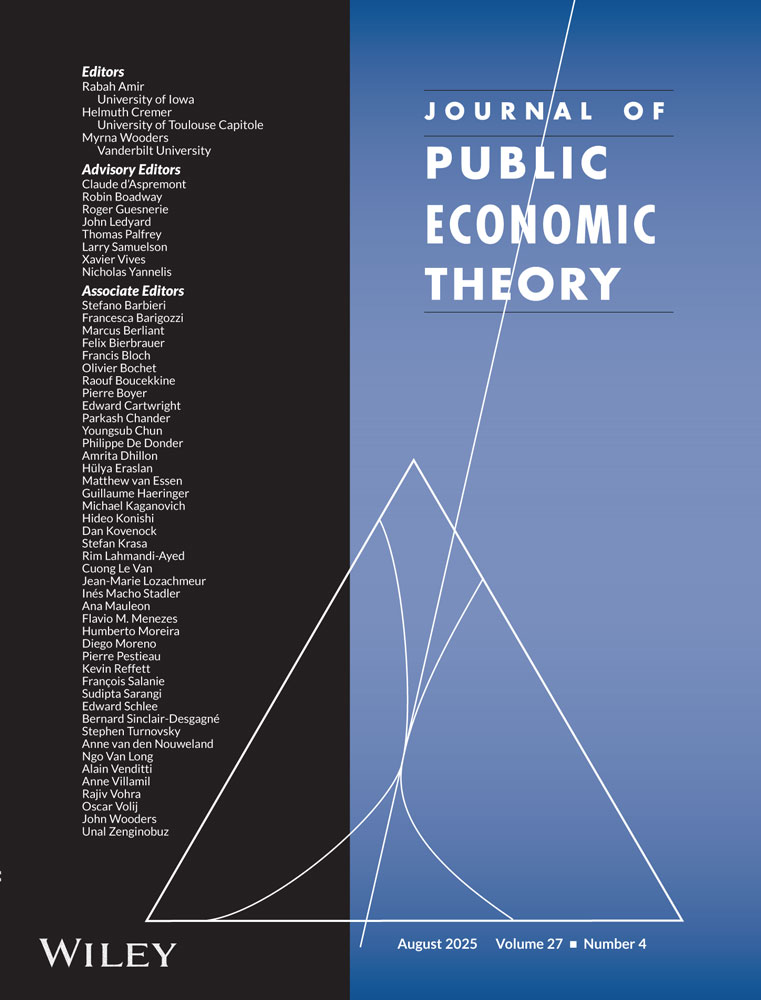Full Access
Restricted and Unrestricted Dominance for Welfare, Inequality, and Poverty Orderings
Abstract
This paper extends the previous literature on the ethical links between the measurement of poverty, social welfare and inequality. We show inter alia, how, when the range of possible poverty lines is unbounded above, a robust ranking of absolute poverty may be interpreted as a robust ranking of social welfare, and a robust ranking of relative poverty may be interpreted as a robust ranking of inequality, and this, for any order of stochastic dominance.
References
- ATKINSON, A. B. (1970) On the measurement of inequality, Journal of Economic Theory 2, 244–263.
- ATKINSON, A. B. (1987) On the measurement of poverty, Econometrica 55, 759–764.
- ATKINSON, A. B. (1998) Poverty in Europe. Oxford : Blackwell Publishers.
- BLACKORBY, C., and D. DONALDSON (1978) Measures of relative equality and their meaning in terms of social welfare, Journal of Economic Theory 18, 59–80.
- DASGUPTA, P., A. K. SEN, and D. STARRETT (1973) Notes on the measurement of inequality, Journal of Economic Theory 6, 180–187.
- DAVIDSON, R., and J. Y. DUCLOS (2000) Statistical inference for stochastic dominance and for the measurement of poverty and inequality, Econometrica 68, 1435–1465.
- DAVIES, J., and M. HOY (1994) The normative significance of using third-degree stochastic dominance in comparing income distributions, Journal of Economic Theory 64, 520–530.
- DONALDSON, D., and J. A. WEYMARK (1986) Properties of fixed-population poverty indices, International Economic Review 27, 667–688.
- DUCLOS, J. Y., and P. MAKDISSI (2001) Restricted inequality and relative poverty, Cahier de recherche 01-06, Département d'économique, Université de Sherbrooke .
-
FIELDS, G. (1980) Poverty, Inequality and Development.
Cambridge
: Cambridge University Press.
10.1017/CBO9780511572173 Google Scholar
- FISHBURN, P. C. (1980) Stochastic dominance and moments of distributions, Mathematics of Operations Research 5, 94–100.
- FISHBURN, P. C., and R. D. WILLIG (1984) Transfer principles in income redistribution, Journal of Public Economics 25, 323–328.
- FORMBY, J. P., W. J. SMITH, and B. ZHENG (1999) The coefficient of variation, stochastic dominance and inequality: a new interpretation, Economics Letters 62, 319–323.
- FOSTER, J. E., J. GREER, and E. TORBECKE (1984) A class of decomposable poverty measures, Econometrica 52, 761–766.
- FOSTER, J. E., and A. F. SHORROCKS (1988a) Poverty orderings, Econometrica 56, 173–177.
- FOSTER, J. E., and A. F. SHORROCKS (1988b) Poverty orderings and welfare dominance, Social Choice and Welfare 5, 179–198.
- FOSTER, J. E., and A. F. SHORROCKS (1988c) Inequality and poverty orderings, European Economic Review 32, 654–662.
- IMMERVOLL, H., C. O'DONOGHUE, and H. SUTHERLAND (1999) An introduction to EUROMOD, EUROMOD Working Paper No. EM0/99.
- JENKINS, S. P., and P. J. LAMBERT (1997) Three ‘I's of poverty curves, with an analysis of UK poverty trends, Oxford Economic Papers 49, 317–327.
- JENKINS, S. P., and P. J. LAMBERT (1998a) Ranking poverty gap distributions: further TIPs for poverty analysis, Research on Economic Inequality 8, 31–38.
- JENKINS, S. P., and P. J. LAMBERT (1998b) Three ‘I's of poverty curves and poverty dominance: TIPs for poverty analysis, Research on Economic Inequality 8, 39–56.
- KAKWANI, N. (1980) On a class of poverty measures, Econometrica 48, 437–446.
-
KOLM, S. C. (1969) The optimal production of social justice, in
Public Economics, J. Margolis and
H. Guitton, eds.
London
: Macmillan.
10.1007/978-1-349-15294-0_7 Google Scholar
- KOLM, S. C. (1976) Unequal inequlity: I, Journal of Economic Theory 12, 416–442.
- RAVALLION, M. (1994) Measuring social welfare with and without poverty lines, American Economic Review 84, 359–364.
- SAUNDERS, P. (1994) Welfare and Inequality. National and International Perspectives on the Australian Welfare State. Cambridge : Cambridge University Press.
- SEN, A. K. (1983) Poor, relatively speaking, Oxford Economic Papers 35, 153–169.
- SHORROCKS, A. F. (1983) Ranking income distributions, Economica 50, 3–17.
- SHORROCKS, A. F., and J. FOSTER (1987) Transfer sensitive inequality measures, Review of Economic Studies 54, 485–497.
- THISTLE, P. (1993) Negative moments, risk aversion, and stochastic dominance, Journal of Financial Quantitative Analysis 28, 301–311.
- WATTS, H. W. (1968) An economic definition of poverty, in On Understanding Poverty, D. P. Moynihan, ed. New York : Basic Books.
- WHITMORE, G. A. (1970) Third degree stochastic dominance, American Economic Review 60, 457–459.
-
ZHENG, B. (1997) Aggregate poverty measures, Journal of Economic Survey
11, 123–162.
10.1111/1467-6419.00028 Google Scholar
- ZHENG, B. (1999) On the power of poverty orderings, Social Choice and Welfare 3, 349–371.
- ZHENG, B., J. P. FORMBY, W. J. SMITH, and V. K. CHOW (2000) Inequality orderings, stochastic dominance and statistical inference, Journal of Business and Economic Statistics 18, 479–488.




